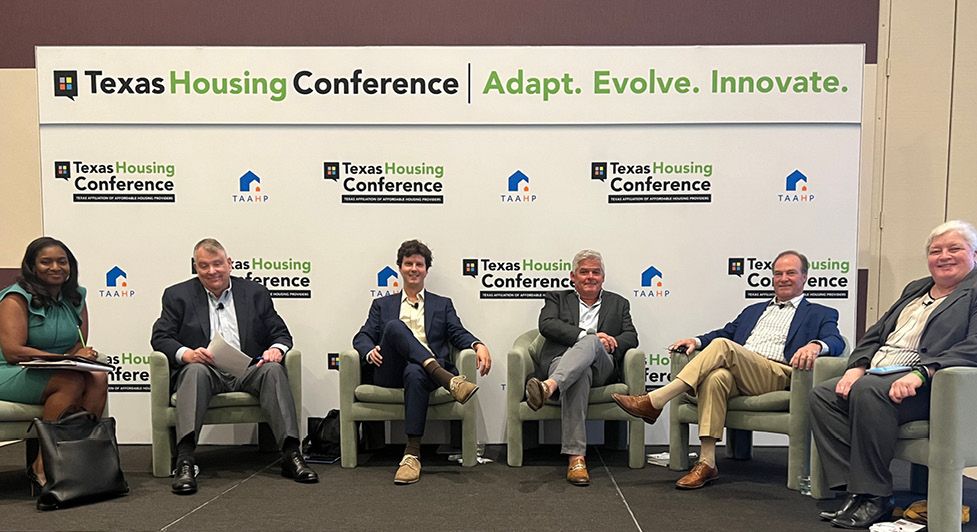Record attendance and packed conference rooms marked this year’s Texas Affiliation of Affordable Housing Providers (TAAHP) conference, which offered important insights on the evolving landscape for multifamily property owners looking to sell.
Owners of affordable housing assets under the Low-Income Housing Tax Credit program are faced with a more challenging environment as they look to tap into potential buyers upon reaching the 15-year compliance mark, a milestone where typically an LP buyout, disposition, refinancing, or qualified contract process takes place.
Given these challenges, conversations at the TAAHP conference were lively and solutions based—with industry stakeholders problem-solving for ways to ride out a cycle increasingly defined by rising interest and insurance rates and other financial hurdles.
“There were more people at this conference than ever before,” said Cliff McDaniel, managing director and head of the affordable housing investment sales team at Lument. “The interest in finding solutions that allow deals to get done is as high as it’s ever been.”
For LIHTC property owners seeing weaker demand, there are several tools and strategies that can help keep properties in the black, while increasing buyer interest. These include potential resyndication deals with new equity partners, public facility corporation (PFC) tax breaks, and a range of short-term and long-term refinancing options from agency lenders such as Lument.
Here’s a closer look at how affordable housing sponsors can stay ahead of the curve until they tap into the right buyer pool.
Recapitalizing Through Resyndication
Resyndication is an important tool for LIHTC property owners regardless of market conditions.
For affordable properties in need of rehab beyond what replacement reserves will cover, sponsors can seek outside investors interested in receiving the benefits of tax credits. These equity backers can include various limited partners and funds as well as other sponsors.
As investors convened at this year’s TAAHP conference the event’s networking component opened doors for new potential equity partnerships. Ryan Nunes, Lument’s director of affordable housing investment sales, said equity resyndication deals are often a good option at Year 15, after existing investors have received their eligible tax write-offs and are ready to exit the deal.
Some property owners may also pursue resyndication for non-tax credit properties in their portfolio. They can raise funding for existing properties before finding new properties to develop.
Additionally, there are compliance considerations that owners need to be mindful of, such as income certification and extended-use agreements for low-income tenants.
Utilizing the PFC Program for Proceeds
PFC tax breaks are another potential option for affordable housing sponsors looking to buy and sell in the Texas market.
Under the PFC program, local officials can offer a full tax exemption to multifamily sponsors as long as a portion of the rental units are set aside for reduced rent. For-profit sponsors can partner with a nonprofit PFC or housing finance corporation (HFC) with ties to the local housing authority to receive the tax breaks. The PFC program includes other kinds of nonprofit entities authorized by local governments in Texas.
An early morning panel in an expansive room at the TAAHP conference was packed due to attendee interest in the PFC program, McDaniel and Nunes said.
McDaniel said the Texas PFC program was changed this June to focus more on affordability. “There are new rules with the PFC program,” he noted. “You’re still going to need to find a public finance corp or other entity that will partner with you. But the PFC structure still works pretty well if you’re going to be doing a resyndication for an acquisition.”
While the PFC exemption is specific to Texas law, other states offer similar tax programs, McDaniel said.
Tapping into New Debt Solutions and Buyer Pools
For LIHTC property owners that are riding out the current cycle, there are also various refinancing options in today’s market. Sponsors looking to transition from short-term bridge debt can still lock fixed-rate financing until they find the right buyers.
In recent years, Fannie Mae and Freddie Mac have introduced new financing products that can help sponsors rehab affordable properties without the use of LIHTCs while still receiving some of the benefits of a tax-exempt loan. These agency loans offer a max LTV of 80% with debt-service coverage at 1.20x and can benefit from extended amortization periods.
While LIHTC sellers are navigating thinner buyer pools, there are opportunities for many sponsors to tap into new lender and buyer relationships. Current market conditions are opening the gate for a new class of mid-market buyers as larger institutional investors pull back.
A handful of attendees at this year’s TAAHP conference had previously only done market-rate deals and showed a lot of interest in the affordable housing space, Nunes said.
“On the affordable housing side, people are still looking to transact,” he noted. “It gets harder with market-rate deals. But if you have a yield-driven affordable asset with a 7+% cap rate going in, that can look very appealing if you get financing at 5.5% or 6%. That’s an attractive spread.”
“I think there are going to be more transactions,” Nunes added. “For more liquidity though, cap rates will have to rise or interest rates need to come down.”
